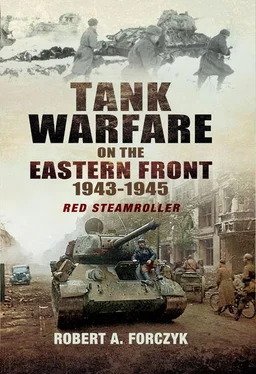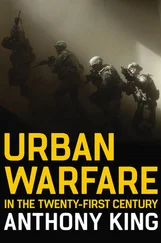General-leytenant Andrei A. Grechko’s 56th Army was assigned the mission of breaking through Rupp’s defences, seizing Krymskaya and then pushing westward to link up with the Soviet naval infantry in the Malaia Zemlya bridgehead. Grechko was provided with five rifle divisions to conduct his breakthrough, but relatively little armour and artillery. He had no large armoured units and his 150–200 tanks were spread across three tank brigades (63, 92, 151), one tank regiment (257) and six OTBs, with a very eclectic mix of tanks. The 151st Tank Brigade was entirely equipped with captured German tanks, abandoned during von Kleist’s retreat from the Terek River. Grechko’s armour also included a large amount of Lend-Lease M3 Lees and Mark III Valentines, but few T-34s. One unit, the 63rd Tank Brigade, had just received 12 M4A2 Sherman medium tanks and was one of the first armour units in the Red Army to employ this new American-built tank in combat on the Eastern Front. {65}
At 0900 hours on 4 April the 56th Army attacked Rupp’s division, but the offensive failed to penetrate the German HKL. Maslennikov temporarily suspended the offensive and made preparations for the 9th and 37th Armies to launch supporting attacks on other parts of the Blue Line to assist Grechko in making a penetration. Additional armour, artillery and air support was also provided. On 14 April, Grechko committed three rifle divisions, each led by a tank battalion (OTB) against the 97.Jäger-Division and succeeded in making a 3km-deep penetration in Rupp’s HKL. Crisolli’s 13.Panzer-Division immediately committed Kampfgruppe Brux to seal the breach but this was not successful. Consequently, Rupp was forced to abandon his forward line and withdraw to his secondary positions. When Grechko’s armour-infantry shock groups rolled forward to occupy the vacated German positions on 16 April, Rupp mounted a spirited counter-attack with a battery of assault guns, supported by Stukas; the Soviets had 48 tanks knocked out, which halted their advance. {66}
During the Kuban Campaign, the Luftwaffe made a concerted effort to improve its low-level anti-tank capabilities. In particular, the Luftwaffe experimented with arming both the Ju-87 Stuka and the Hs-129B-3 with the 3.7cm Flak gun. Hauptmann Hans-Ulrich Rudel was provided with a few prototypes of the Ju-87G and sent to the Kuban to test the new weapon against Soviet armour. The Ju-87G’s two 3.7cm cannons, each with a six-round magazine, fired APCR rounds with tungsten carbide penetrators. The APCR rounds had a muzzle velocity of 1,170 m/sec and could penetrate up to 38mm of armour; the T-34’s rear deck armour was limited to only 16–20mm of protection. Although Rudel was shot down by anti-aircraft on his first combat sortie in the Ju-87G, he quickly became a staunch advocate of the new method of destroying Soviet T-34s. {67} Based on his endorsement, limited production of the Ju-87G began in June 1943 and a small number would be available for Operation Zitadelle .
Meanwhile, Grechko continued attacking Rupp’s defensive positions from 29 April–4 May and committed 60 tanks on one day, as well as massive air support. Luftflotte 4 made a major effort to gain air superiority over the Krymskaya sector, inflicting painful losses on the 4VA, but could not stop the incessant Soviet bombing and low-level attacks. Finally, Rupp was forced to abandon Krymskaya and pull his HKL back west of the city. However, the new German line was just as solid and Maslennikov had to pause to reinforce the 56th Army and prepare for a larger set-piece offensive. Disappointed by Maslennikov’s failure to achieve a breakthrough, the Stavka decided to replace him with General Ivan E. Petrov, who had conducted the unsuccessful defence of Sevastopol in 1942. The Stavka also provided the 1448th and 1449th Self-Propelled Artillery Regiments (SAP), equipped with Su-76 and Su-122 guns, to spearhead a new offensive. Petrov decided to shift his attack axis northward, to make the main effort against the 101.Jäger-Division with the 37th Army this time, while Grechko made a supporting attack against Rupp. On 26 May, Petrov’s Front began a 100-minute artillery preparation. However, the Soviet infantry was unable to penetrate the Blue Line and when the Soviet armour (a mix of T-34s, M3 Lees and Valentines) was committed, it became immobilized in the German minefields and was shot to pieces by assault guns, anti-tank guns and Rudel’s Stukas; the Germans claimed 100 tanks destroyed on the first day of the new Soviet offensive. This number was likely exaggerated since many tanks immobilized by mines were subsequently recovered. On the positive side, Soviet air support for the attack was impressive and a new tactic was used, whereby Il-2 Sturmoviks dropped smoke bombs in front of advancing tank-infantry shock groups in order to reduce the effectiveness of the German defensive fire. Soviet air-ground cooperation was improving.
In order to prevent a breakthrough of the Blue Line, Crisolli’s 13.Panzer-Division dispatched Kampfgruppe Polster (two understrength Panzer-Kompanie from Panzer-Regiment 4 with 12 Pz IV tanks and Müller’s assault guns) and Kampfgruppe Gaza (the I./Panzergrenadier-Regiment 66, which had only a single company of SPWs and some artillery) to counter-attack the Soviet shock groups. {68} Over a period of several days, the Soviet offensive was blunted and then stopped. The Blue Line would hold for another three and a half months. Rupp did not live to see this, however, since he was killed by a Soviet air raid on his command post on 31 May. By early June, Petrov’s offensive had been halted, although local attacks kept the pressure on AOK 17 in order to prevent the Germans from transferring units from the Kuban to reinforce Heeresgruppe Süd. Indeed, Crisolli’s 13.Panzer-Division would remain in the Kuban until late August 1943 and two assault-gun battalions would remain there until AOK 17 evacuated the Taman Peninsula in September. While the Germans were able to achieve a defensive victory in the Kuban, the forces committed there would have been better employed in von Manstein’s command.
For the Red Army, the Kuban proved a useful arena for learning how to crack open German defensive positions, as well as learning how to improve their combined arms tactics. The Soviet use of armour in the Kuban was limited to brigade-size infantry support attacks, which suffered heavy losses due to the density of German defences, but important lessons were learned in coordinating these attacks with artillery and close air support. The days of Soviet tank units attacking without adequate supporting fires was drawing to a close.
Building up for the Showdown, April–June 1943
By the end of March 1943, both sides were completely exhausted and incapable of further sustained offensive action until their depleted air and tank formations were refitted. The Germans had lost 2,152 tanks during January–March 1943 (many were non-operational tanks abandoned during the retreats or lost at Stalingrad) and only 53 per cent of their remaining 1,500 tanks were operational after von Manstein’s counter-offensive concluded. {69} The Red Army had also suffered huge tank losses – 5,023 tanks lost in January–March. {70} However, the three months that followed brought a lull period that both sides used to refit their forces for the next test of strength.
How did the armoured units and tankers on both sides use this unusual three-month ‘quiet’ period in April–June 1943? As much as possible, tank units on both sides were pulled back from the front line in order to conduct maintenance and rest crews, but they were still within range of harassing artillery fire and occasional air attacks. Typically, armoured units dispersed, with each tank company being assigned a reconstitution area in or near a small village. Upon arrival, tanks were camouflaged and troops were given rest time after basic maintenance was completed. When possible, worn track blocks and road wheels were replaced and there were always air filters to clean. Unteroffizier Erich Hager, a Pz IV crewmen in the II./Pz. Rgt. 39 in 17.Panzer-Division, kept a detailed war diary and noted a variety of activities during the lull. Like many front-line soldiers, once the action stopped thoughts turned to alcohol, sex and rest, in that order. Hager noted on 25 April, that ‘provisions arrive. We get thoroughly drunk. Otherwise nothing happens.’ The unit lived in tents in the field near a village and had sufficient ‘down time’ to play soccer games on the steppe and go swimming in local streams. Later, Hager and his comrades were able to gain some R&R (rest and recreation) time in Kharkov and spent it skirt-chasing and bar-hopping. While some soldiers were granted home leave during this period, Hager was assigned to take driver training (earning his Class 1 licence) and radio operator training. {71} Surprisingly, the Germans conducted relatively little large-scale training, although company-and battalion-level training did occur. The spring rainy period lasted from 18–30 May, rendering large-scale training difficult. Soviet tankers had much less time for R&R and their brigade political officers filled most spare moments with field lectures.
Читать дальше








![John Stieber - Against the Odds - Survival on the Russian Front 1944-1945 [2nd Edition]](/books/405234/john-stieber-against-the-odds-survival-on-the-russian-front-1944-1945-2nd-edition-thumb.webp)



